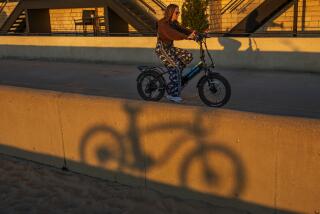Bicyclists, Please Use Your Heads and Wear Your Helmets
- Share via
As his 6-year-old daughter careened down the street on her new two-wheeler, the orthopedic surgeon yelled after her, “Don’t worry! You can’t break anything I can’t fix!” A neurosurgeon, more familiar with the brain injuries caused by cycling accidents, would not have agreed.
In fact, bicycling is a relatively common cause of head trauma and brain injury, responsible for hundreds of deaths and more than 100,000 emergency room visits each year in the United States. Safety experts have identified several simple steps that, if followed, could dramatically reduce these numbers.
The first, of course, is to wear an approved bicycle helmet every time you ride--no matter how short or familiar the trip. This step is so important that it is illegal for people younger than 18 to ride without one in California. Studies show that these helmets reduce the risk of injury to the skull and brain by as much as 85%. In spite of these powerful statistics, bike helmets are grossly underutilized. Only about 18% of cyclists in the U.S. report that they wear helmets all or most of the time.
Excuses for not wearing a helmet vary: The approved helmets are too expensive; they are uncomfortable; they don’t look “cool” (a typical remark from teenagers). All of these excuses look foolish after a bike-related head injury.
Not just any helmet will do the job. To provide your brain with real protection, your helmet must meet standards set by the Consumer Product Safety Commission. These standards require that helmets pass performance tests and help to ensure that they will provide sufficient protection and stay in place in the event of a collision or fall. CPSC-approved helmets are widely available for $20 or less--far less than the price of a bicycle.
To provide optimal protection, the helmet must also fit properly and be worn appropriately. A correctly fitted helmet should sit level on top of your head (not perched on the back of the head or forehead), with the front of the helmet covering most of your forehead and resting just above the top of your eyebrows. The helmet should not move much in any direction (back-to-front or side-to-side) after the chin strap is secured. (If necessary, foam pads can be inserted into the helmet to help improve the fit.)
Once you’ve selected a helmet and strapped it on, your goal while riding should be to prevent it from ever hitting the ground (or any other hard object, like a tree or a car). The following safety precautions will help you accomplish that goal:
* Never ride a bike that is incorrectly sized for your height and weight; oversize bikes are particularly dangerous. While sitting on the seat with your hands on the handlebars, you should be able to place the balls of both feet on the ground. When selecting a bike for child, put the child on the bike before you buy it; never buy a bike that’s too large for the child in the hope of getting more mileage out of it.
* Follow the same basic traffic rules that apply to cars and trucks. Ride with traffic; obey traffic signs and signals; give hand signals to let drivers know when you are turning or changing lanes; and never enter a traffic lane without first checking to be sure it is safe to do so. Ride defensively and never assume that cars will see you.
* When riding in a group, do not blindly follow the leaders through intersections. Stop or slow at each intersection, and make your own determination that it is still safe to proceed.
* When riding at night, use front and rear lights and reflectors (to be “street legal” at night, a bike must have reflectors front and rear, on the pedals, and on the side rim or wheel); wear reflective clothing (vest, bands on arms and legs, tape on helmet); and avoid unlighted, narrow roadways.
* Children should never be allowed to ride at night--even if accompanied by adults.
If a child is riding as a passenger on your bike, use a child carrier with a high back, a lap and shoulder harness, and foot guards. The carrier should be firmly fastened to the bike, the harness buckled snugly around the child. The child must also wear a correctly sized, approved helmet. Never carry a baby less than 1 year old on a bicycle, as children of this age do not have sufficient neck strength to safely wear a helmet.
If, at any time, you fall from a bike (even while standing still) and your helmet strikes the ground, purchase a new one or return your old one to the manufacturer for inspection before using it again--even if there is no visible damage. After sustaining an impact, the protective layer of foam inside a helmet can become cracked or slightly crushed, which impairs its effectiveness.
To help educate children about bicycle safety, take the “bike tour” on the U.S. Department of Transportation Web site at https://www.nhtsa.dot.gov/kids/biketour/index.html.
*
Dr. Jonathan Fielding is the director of public health and the health officer for the Los Angeles County Department of Health Services. Dr. Valerie Ulene is a board-certified specialist in preventive medicine practicing in Los Angeles. Send questions by e-mail to: ourhealth@dhs.co.la.ca.us. Their column appears the second and fourth Mondays of the month.






